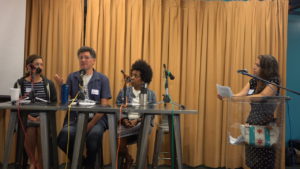Building and Sustaining Food Co-operatives
Since food sustains life, we need to create member-owned outlets, so that we can control where and from whom we sustain ourselves. How do we go about establishing this ecosystem?
Notes
What common reasons that folks provide for wanting to start a co-op?
Vanessa: I live and work in the Austin community, a food desert. I wanted to create a conventional grocery store in a community that doesn’t have many healthy options. I have been working on it awhile, and find that folks are unaware of what co-ops are. My struggle going forward is inform people about co-ops. I often hear, “Oh, is that a commune”? One of the things we’re starting with is an engagement plan. In our community, it’s to create community through food and to create community wealth. We want something that people can feel good about.
Greg: Three pillars make up the foundation of our cooperative, community, community wealth, and food. We started to create Chicago Market four years ago on north side of Chicago. And recently signed a lease. Lots of options exist down the street and none provide those 3 things! A major choice of local and organic food doesn’t really exist. Champaign, Madison, and Minneapolis, and within Chicagoland, Oak Park and Logan Square, all host food cooperatives. No options exist on the Northside. All this wonderful food being grown around us! Our values include solidarity and equity. Other grocery stores, formerly Dominic’s now Mariano’s (owned by Kroger) and Whole Foods (now owned by Amazon) have profit as their value.
Sharon: In 2004, when organic & local food wasn’t as readily accessible, we started creating Dill Pickle Food Cooperative. The founders focused on changing the landscape of the neighborhood and providing everyday access to good healthy food. Their motivations included meeting community needs, providing produce from local farmers everyday and spreading the ownership out across the community without a single proprietor. Nine years later, we have expanded and are proud and happy to be demonstrating this consumer model.
What are the stages of opening a food co-op?
Sharon: From the initial idea in 2004, we developed our bylaws by 2006 and opened our first store in 2009, five years after the initial idea. When we planned our expansion, it was like being a startup all over again. It’s all extremely challenging. Consumer education and community education is an ongoing challenge. However the biggest, first hurdle turned out to be the financing. Of the 3.5M required to start the store, we raised $1M from owner loans. (200 loans, varying from 1k to over $100,000) + Chicago Community Loan Fund (Shared Capital). We enjoy financing entirely by individuals and organizations aligned with our values. At height of recession, we obtained $150,000 and lots of love with no bank debt.
Greg: Three major stages mark the food cooperative movement: the 1930s when federal law passed allowing existence; the 1960’s when folks grew in awareness about organic food and sustainability; today’s third wave, with more food co-ops being developed now than any other time. National and local organizations supported our development, including Principle Six (a coalition of cooperatives based on the 6th principle of cooperatives, cooperation among cooperatives) and the Dill Pickle Food Cooperative. We just got space, a lease on a building, which took four years, including one year of looking for a building and another year negotiating the lease. We need $5M to build out and open the store. We are working with same funders as Dill Pickle, including the owner loan program with our owners. At this point we have 1,350 of 2,000 members needed to unlock the rest of the financing, preliminary drawings of a store plan, and are thinking about hiring a general manager.
Vanessa: We are at the beginning of a startup phase. Most coops start as a group; at this point only two of us are actively working on it. We need to recruit a steering committee. We’re planning our first Community Town Hall Meeting in October. Fortunately, Alec is acting as an intern for three-four months as we plan our next stages; 1) Establish steering committee, 2) conduct a feasibility study 3) ?? The UIC Urban Planning Department through Stacy Sutton’s class helped with feasibility study.
How do food cooperatives differ from CSAs, buying clubs, etc.?
Definitions
- CSA; consumer supported agriculture models typically develop contracts between the farmer and the CSA subscribers, where subscribers pay a specific amount per season for a box of produce every week during the season.
- Farmers: vendors, who grow food and sell it on the market either at farmers markets, or more typically into the traditional agribusiness supply chain.
- Buyers Clubs: cooperative buying model, where members consolidate orders and volunteer to order/transport (if neccesary)/unpack/rebundle orders into packages for each owner to pick up.
- Food Cooperatives: storefronts where folks can become members. open to public (most)
Sharon: Food cooperatives typically organize themselves to meet the needs of their owners. Usually they hire a director/manager and staff, although some operate on a worker collective basis. Other multi-stakeholder models base themselves on consumer owner, a higher equity-higher return worker share with governance reps on board. Recently the Alberta cooperative converted from consumer to worker ownership. Other models have a unionized worker staff. No matter the model, cooperatives usually offer one vote per member (membership possbibly being a household) and adhere to the Seven Principles In terms of capital structures, we’re seeing lots of variety exploding on the scene.
Greg: Illinois law states that food cooperatives operates for the benefit of owners. That’s it! It means that cooperatives enjoy significant freedom. However, federal labor laws provide challenges which which to work, as the Department of Labor can get confused about them.
Vanessa: Consumer owned or a hybrid of worker/consumer-owned make up the bulk of food cooperatives. The worker-owned piece can help wealth building aspect, as in the Cleveland Model.
What challenges and obstacles have you encountered? On average it takes five to seven years from idea to opening. Why so long?
Sharon: It’s surprising, how long it takes and how much it costs. I was brought on after opening, am still learning as I go. It’s a challenge to stick to your guns. Ongoing challenge is to build up conversation about the economic power of conversation. Why bother? community, sense of belonging. We have 1,300 sq ft and a staff ranging from 12 to 40+. How to you manage change? What do you hold on to? What do you dump? Where do you draw the lines?
Greg: The staggering amount of time it takes provides a significant challenge We started in 2014, now have 1,300 owners, and know, at minimum, it will be 12-18-24 months before we open. That’s a 6 year process…but lots of folks working on this before we open. 1) 1 person at a time says, “I’m gonna commit resources. 2) It was far harder to find a building than we thought. We looked at 40 buildings that would’ve been wrong. 3)Then we have to develop construction drawings, hire agencies and contractors, work with unions, plan how we will handle garbage, etc. This all rides on the back of unpaid volunteers working huge amounts of hours… so why bother? Community: we believe that this store will be more than sum of our parts, a long-lived entity in the world that embodies cooperative values
Vanessa: Our greatest challenge to-date has been finding committed community members. time, skills, effort. We are in it for the long haul, but it’s a big commitment. We need passionate people that see that healthy food options, community wealth as being neccesary. see what’s possible. How do you find folks: start with pool of people already engaged, already holding community commitments.
What’s the best thing you have experienced in your food cooperative?
Vanessa: It’s been building community, seeing what is possible. Our predominantly black community with lot of blight provides opportunities to see what’s possible.
Greg: part of this is unlike any other org. shopping @food co-op is diff in terms of energy, feel commitment. diff than folks just working. know staff, know shoppers. comm of people gathered around food, around shared commitment. excited to walk in to CM!
Sharon: People! Environment! Social gatherings! Knowing where every dollar goes feels really good. The future and being here in Chi, with so much momentum building around cooperatives, across sectors. at a time when warmth consolidation is at terrifying high. Our city sits at the center of alternatives.
Questions &Answers.
Q: sharon: workers. consumer co-ops. // sharon: personally interested. unionized with the IWW. much larger staff, still learning about coop model, what’s possible. lots of edu to be done. potential there!
nancy: “you don’t have to be a worker co-op to treat your workers right.”
Q: ways in which acquired wisdom for establishing successful co-ops can speed process?
- national org: Food Co-op Initiative.
- co-ops across sectors.
- online: industry: you’ll find national orgs!
Q: VCC markets with 11 stores // expansion goals for co-ops // or preference for cooperating as individual co-ops
- ChiMkt, Dill Pickle+ others: Chi co-op coalition.
- can we get to a place where we share economic resources like HR, purchasing, etc. how can we work together to grow market share.
- eg MN:
Q: Vanessa:
- beautiful thing about co-ops is that we want everyone to be involved.
- oak park has 10 grocery stores for 50K people.
- great bridge to have folks form other communities to help.
- white folks are afraid to come into communities of color.
- can have a truly integrated society. can be revolutionary.
- from north side. see myself as connector.
Accounting best practices available as as handout from Nancy.

